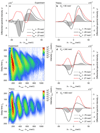Lightwave-driven quasiparticle collisions on a subcycle timescale
- PMID: 27172045
- PMCID: PMC5034899
- DOI: 10.1038/nature17958
Lightwave-driven quasiparticle collisions on a subcycle timescale
Abstract
Ever since Ernest Rutherford scattered α-particles from gold foils, collision experiments have revealed insights into atoms, nuclei and elementary particles. In solids, many-body correlations lead to characteristic resonances--called quasiparticles--such as excitons, dropletons, polarons and Cooper pairs. The structure and dynamics of quasiparticles are important because they define macroscopic phenomena such as Mott insulating states, spontaneous spin- and charge-order, and high-temperature superconductivity. However, the extremely short lifetimes of these entities make practical implementations of a suitable collider challenging. Here we exploit lightwave-driven charge transport, the foundation of attosecond science, to explore ultrafast quasiparticle collisions directly in the time domain: a femtosecond optical pulse creates excitonic electron-hole pairs in the layered dichalcogenide tungsten diselenide while a strong terahertz field accelerates and collides the electrons with the holes. The underlying dynamics of the wave packets, including collision, pair annihilation, quantum interference and dephasing, are detected as light emission in high-order spectral sidebands of the optical excitation. A full quantum theory explains our observations microscopically. This approach enables collision experiments with various complex quasiparticles and suggests a promising new way of generating sub-femtosecond pulses.
Conflict of interest statement
The authors declare no competing financial interests.
Figures













Comment in
-
Quantum-matter physics: Quasiparticles on a collision course.Nature. 2016 May 12;533(7602):186-7. doi: 10.1038/533186a. Nature. 2016. PMID: 27172042 No abstract available.
References
-
- Rutherford E. The scattering of α and β particles by matter and the structure of the atom. Philos Mag Series 6. 1911;21:669–688.
-
- Wyatt T. High-energy colliders and the rise of the standard model. Nature. 2007;448:274–280. - PubMed
-
- Chemla DS, Shah J. Many-body and correlation effects in semiconductors. Nature. 2001;411:549–557. - PubMed
-
- Almand-Hunter AE, et al. Quantum droplets of electrons and holes. Nature. 2014;506:471–475. - PubMed
-
- Basov DN, Averitt RD, van der Marel D, Dressel M, Haule K. Electrodynamics of correlated electron materials. Rev Mod Phys. 2011;83:471–541.
Publication types
Grants and funding
LinkOut - more resources
Full Text Sources
Other Literature Sources

